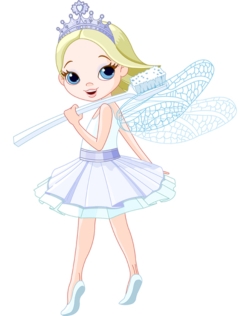History of the Tooth Fairy
 Next to Santa Claus the Tooth Fairy is the best known fantasy figure of early childhood. However, the Tooth Fairy, as we know her, is a modern creation and only appeared in the last 100 years.
Next to Santa Claus the Tooth Fairy is the best known fantasy figure of early childhood. However, the Tooth Fairy, as we know her, is a modern creation and only appeared in the last 100 years.
Tradition of the Tooth Fairy
Although there is no one universally recognized ritual surrounding the Tooth Fairy, the most common one involves placing a lost baby tooth under the child’s pillow before bedtime. Many parents will purchase or make a special Tooth Fairy pillow that has a small pouch to place the tooth. When the child falls asleep, the parent then carefully removes the tooth and replaces it with a small sum of money. When the child awakens, they then discover the money and are told some variation of the explanation “the Tooth Fairy left it in exchange for your tooth!”
The Tooth Fairy is primarily an American / European tradition. There are many slight variations or embellishments, such as a gift other than money or placing a little glitter on the floor of the child’s room as leftover fairy dust from the Tooth Fairy’s visit. Thanks to websites such as Pinterest, many parents are making visits from the Tooth Fairy more and more elaborate so they can document it online.
The amount of money children receive for each tooth varies greatly, but the average going rate for a tooth in the United States is $3.70, according to a study done by Visa in 2013. Most parents use a sliding scale to decide the value of the tooth, factors such as size of tooth, how visible the gap left by the tooth is, if multiple teeth were lost at the same time and age of the child to determine how much money to leave. A handy tip for parents is to pull the money out of the wallet before sneaking into the child’s room because it’s possible to mistake a dollar bill for a twenty dollar bill in the dark.
Origins of the Tooth Fairy
The Tooth Fairy evolved from the early European traditions where a child was given a gift or money under their pillow when their sixth tooth fell out. Vikings who thought children’s teeth would bring them luck in battle would pay children for their teeth. The early European tradition, Viking tradition and a few other most likely combined to form what we now know as the Tooth Fairy.
Although those rituals surrounding children’s baby teeth date back to the Middle Ages, the Tooth Fairy is a fairly modern invention. The earliest known appearance of the Tooth Fairy was less than a hundred years ago, when a popular 1927 play by Esther Watkins Arnold first featured the Tooth Fairy. Then, in 1949 the Tooth Fairy gained widespread popularity thanks to a short story by Lee Rogow.
There is no universally agreed upon details regarding the Tooth Fairy’s physical appearance and thanks to Hollywood we’ve seen many different incarnations. Even The Rock has been depicted as the Tooth Fairy! Thanks in part to Disney’s Tinkerbell most people envision the Tooth Fairy as a dainty female attired in a ballerina type costume. She is often depicted as being able to fly using wings attached to her back, and carrying a wand
Psychological Benefits for the Tooth Fairy
Some psychologists have suggested that the Tooth Fairy plays a positive role in the lives of young children by helping to remove some of the anxiety that naturally arises from the loss of their baby teeth. Relieving such anxiety may also make it easier for children to accept the role of dentistry in their lives as they mature. Few children maintain a belief in the Tooth Fairy past five or six years old, which is around the same time that most children abandon their belief in Santa Claus.
Overall the Tooth Fairy is a fun way for children and their parents to celebrate some steps in growing up and makes for the perfect opportunity to teach kids about good oral hygiene.




